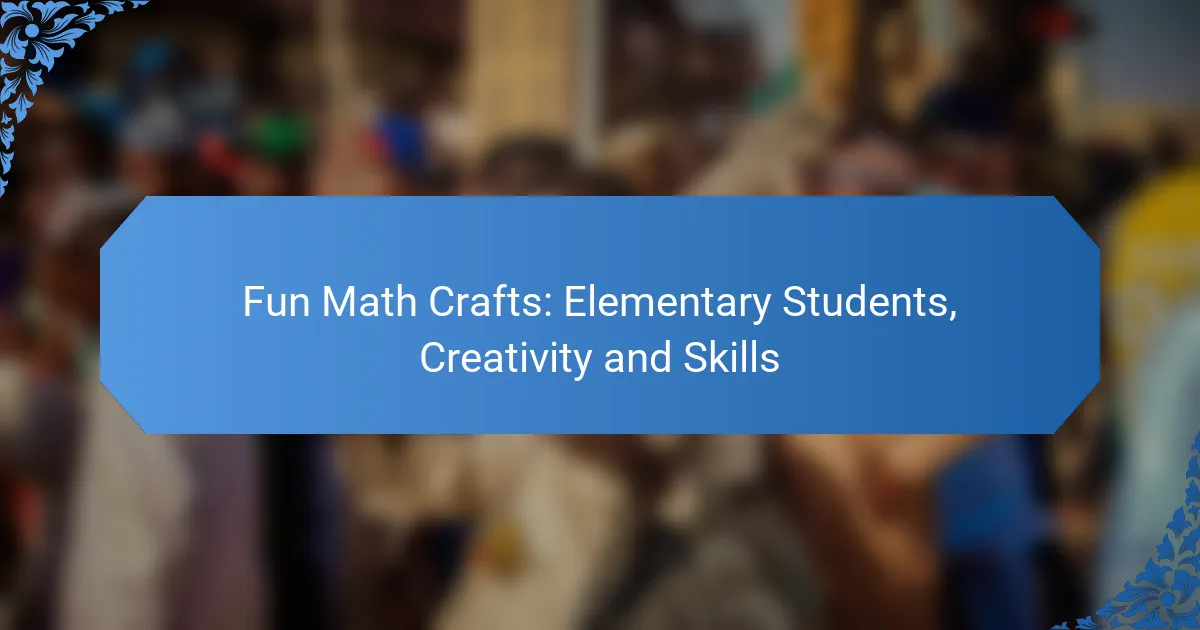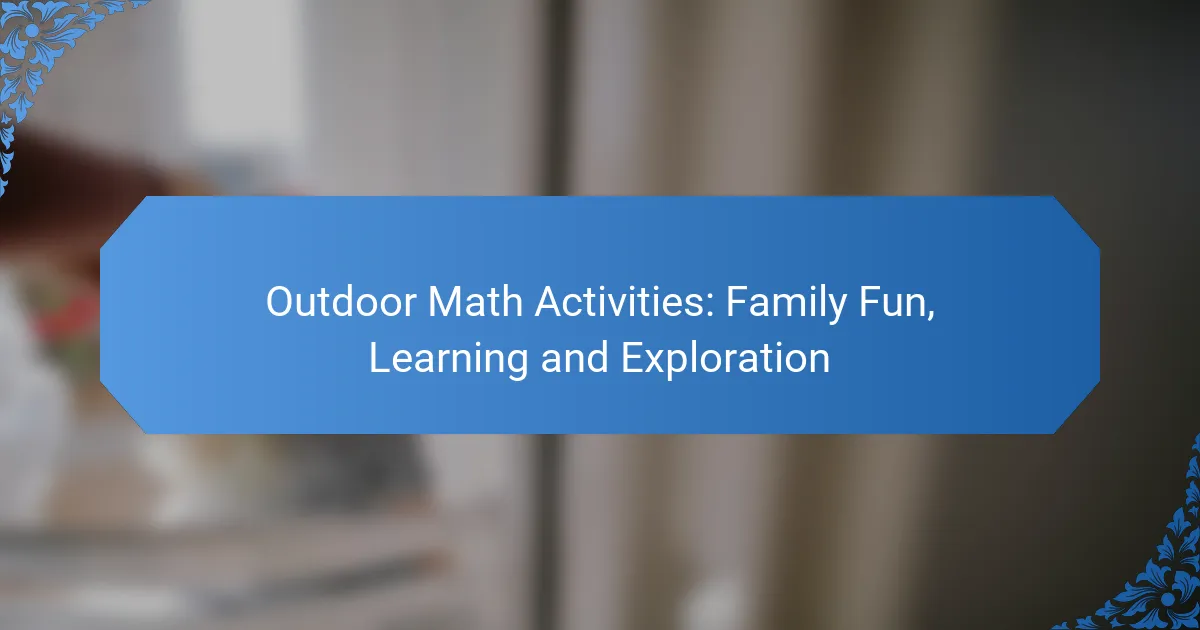Math crafts offer a unique way to engage elementary students by blending creativity with fundamental mathematical concepts. These hands-on activities not only make learning enjoyable but also promote critical thinking and artistic expression, helping students to deepen their understanding of math while developing essential skills.
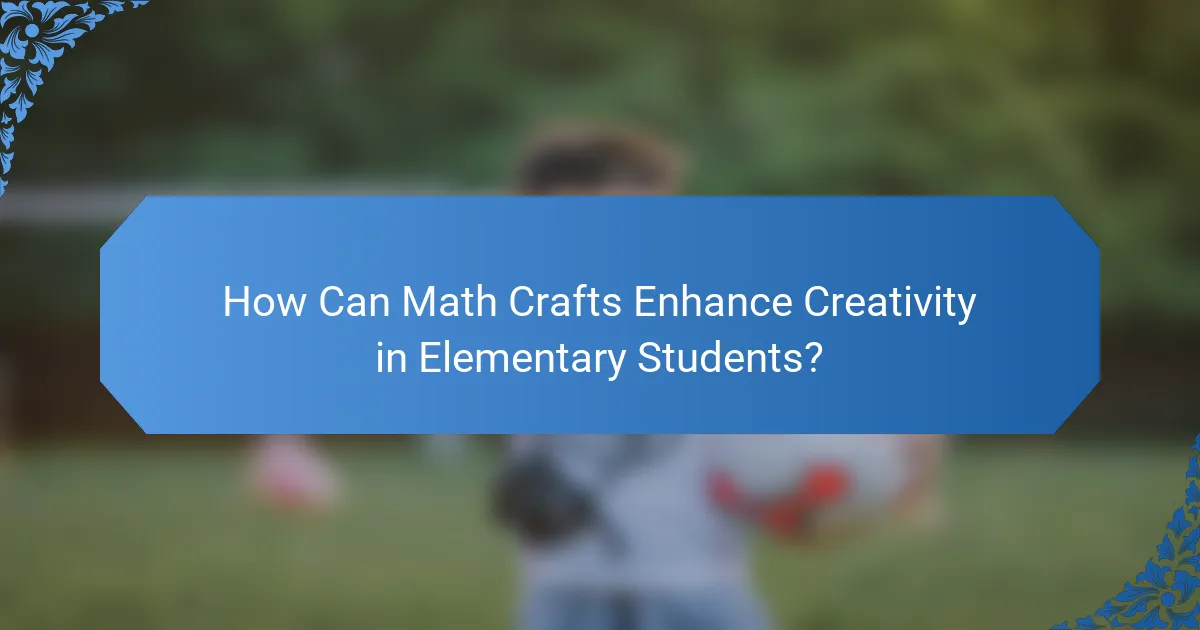
How Can Math Crafts Enhance Creativity in Elementary Students?
Math crafts enhance creativity in elementary students by combining mathematical concepts with hands-on activities. This approach not only makes learning enjoyable but also encourages students to think critically and express themselves artistically.
Encourages hands-on learning
Hands-on learning through math crafts allows students to physically manipulate materials, which helps solidify abstract concepts. For example, using geometric shapes to create a 3D model can make the properties of those shapes more tangible.
Activities like building a paper mache globe or creating a mosaic can engage students in active learning, making math more relatable and enjoyable. This tactile approach fosters a deeper understanding of mathematical principles.
Fosters problem-solving skills
Math crafts often involve challenges that require students to devise solutions, enhancing their problem-solving skills. For instance, designing a structure with limited resources teaches students to think critically about materials and design principles.
Encouraging students to brainstorm different approaches to a craft project can lead to innovative solutions and a greater appreciation for the problem-solving process. This skill is invaluable not only in math but across all subjects.
Stimulates artistic expression
Integrating art into math crafts allows students to express their creativity while reinforcing mathematical concepts. Projects like creating patterns or designing fractals can inspire students to explore their artistic side while applying math skills.
Artistic expression in math crafts can take many forms, from painting geometric shapes to crafting sculptures that illustrate mathematical ideas. This blend of disciplines nurtures a well-rounded educational experience.
Builds confidence through creation
Completing math crafts gives students a sense of accomplishment, which boosts their confidence. When students see their ideas come to life, they gain pride in their work and a belief in their abilities.
Encouraging students to showcase their creations can further enhance their self-esteem. Sharing their projects with peers or family members reinforces their achievements and motivates them to tackle more complex challenges.
Integrates math with art
Integrating math with art through crafts provides a unique way to explore both subjects simultaneously. Projects like creating tessellations or designing geometric art can illustrate how math is present in everyday life and artistic endeavors.
This integration helps students recognize the relevance of math beyond the classroom, fostering a more holistic understanding of both disciplines. It encourages them to see the beauty in mathematical patterns and structures.
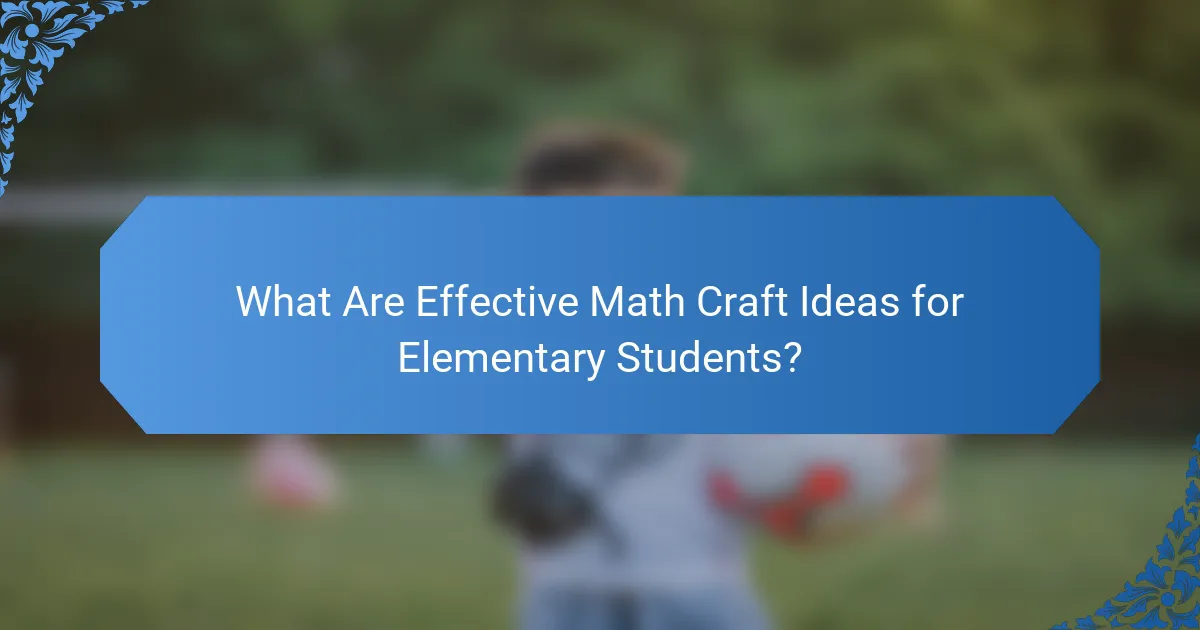
What Are Effective Math Craft Ideas for Elementary Students?
Effective math craft ideas for elementary students combine creativity with fundamental math concepts, making learning engaging and hands-on. These activities not only enhance understanding of mathematical principles but also foster creativity and critical thinking skills.
Origami for geometry
Origami is an excellent way to teach geometry through hands-on folding activities. Students can learn about shapes, angles, and symmetry while creating various paper models. Simple projects like folding a square into a triangle or making a paper crane can illustrate these concepts effectively.
To get started, provide students with origami paper and step-by-step instructions. Begin with basic shapes and gradually introduce more complex designs as their skills improve. This approach helps reinforce geometric vocabulary and principles in a fun way.
Math-themed collage projects
Math-themed collage projects allow students to express their understanding of mathematical concepts through art. By using magazines, colored paper, and other materials, students can create visual representations of numbers, shapes, or even mathematical operations.
Encourage students to incorporate elements like graphs, charts, or number lines into their collages. This not only reinforces their math skills but also enhances their creativity. Set clear guidelines on the math concepts to include, ensuring that the project remains focused on learning.
Building geometric shapes with straws
Building geometric shapes with straws is a hands-on activity that helps students visualize and understand three-dimensional figures. By connecting straws with connectors or tape, students can create various shapes such as cubes, pyramids, and prisms.
Provide a variety of straw lengths and connectors to allow for creativity in their designs. This activity can also lead to discussions about surface area and volume, making it a comprehensive learning experience. Remind students to count the edges and vertices of their shapes to reinforce their understanding.
Creating math games with crafts
Creating math games with crafts engages students in learning through play. By designing board games, card games, or interactive activities, students can practice math skills in a fun and collaborative environment. For example, a simple board game can involve solving math problems to advance on the board.
Encourage students to develop rules and objectives for their games, ensuring they align with specific math concepts. This not only reinforces their learning but also fosters teamwork and communication skills. Provide materials like cardboard, markers, and dice to facilitate their game creation process.
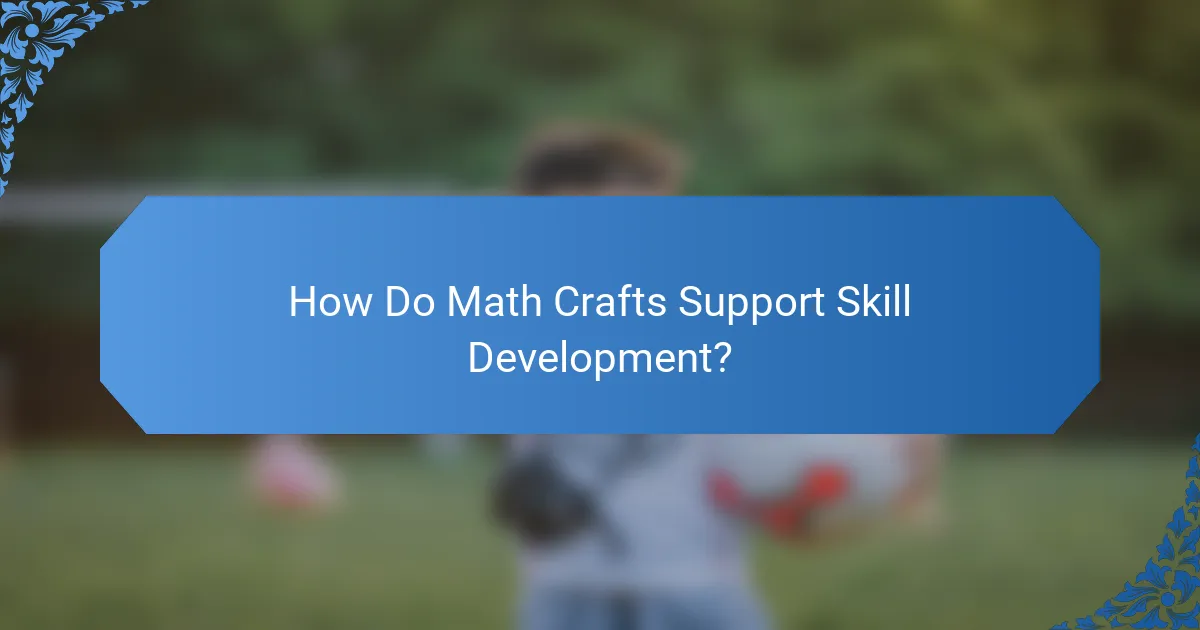
How Do Math Crafts Support Skill Development?
Math crafts support skill development by integrating hands-on activities that enhance various cognitive and physical abilities. These creative projects engage students in practical applications of mathematical concepts, fostering a deeper understanding while developing essential skills.
Enhances fine motor skills
Engaging in math crafts requires precise hand movements, which significantly enhances fine motor skills. Activities like cutting, folding, and assembling materials help students refine their dexterity and coordination.
For example, creating geometric shapes from paper involves careful cutting and gluing, allowing children to practice and improve their grip strength and control. Regular participation in such crafts can lead to noticeable improvements in tasks requiring fine motor precision.
Improves spatial awareness
Math crafts are effective in improving spatial awareness by requiring students to visualize and manipulate objects in space. Projects that involve building models or arranging shapes help children understand dimensions and relationships between different elements.
For instance, constructing a 3D shape from 2D templates encourages students to think about how flat surfaces come together to form a solid object. This hands-on experience solidifies their understanding of spatial concepts and geometry.
Strengthens critical thinking
Participating in math crafts promotes critical thinking as students must plan, problem-solve, and make decisions throughout the crafting process. They learn to approach challenges methodically, evaluating different strategies to achieve their goals.
For example, when designing a math-related game, students must consider rules, scoring, and materials, which encourages them to think critically about how to make their project engaging and educational. This process enhances their analytical skills and creativity.
Encourages teamwork and collaboration
Math crafts often involve group activities that foster teamwork and collaboration among students. Working together on projects helps children develop communication skills and learn to value different perspectives.
For instance, creating a large mural that incorporates various math concepts requires students to share ideas, delegate tasks, and support each other. This collaborative environment not only strengthens their social skills but also reinforces their understanding of mathematical principles through shared learning experiences.
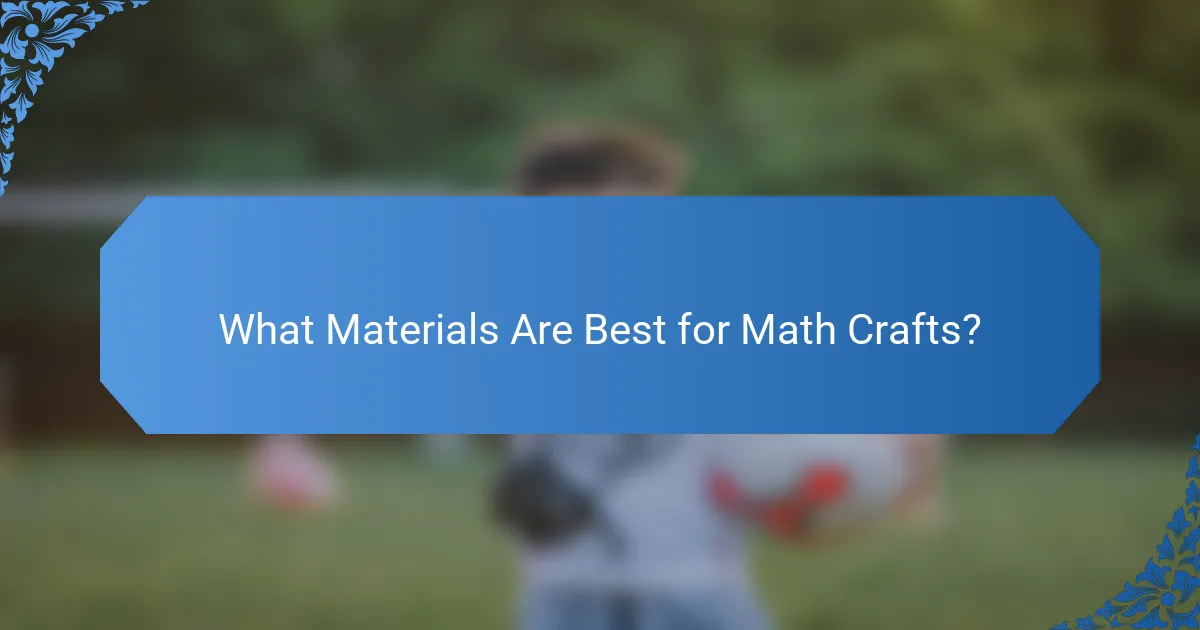
What Materials Are Best for Math Crafts?
For effective math crafts, a combination of recyclable materials, craft supplies, digital tools, and math manipulatives works best. These materials not only enhance creativity but also support hands-on learning, making math concepts more tangible for elementary students.
Recyclable materials
Recyclable materials like cardboard, plastic bottles, and paper can be excellent resources for math crafts. They are often free or low-cost, making them accessible for classroom projects or home activities. Encourage students to think creatively about how to repurpose these items into math-related designs.
Common examples include using cardboard to create geometric shapes or plastic bottle caps to represent numbers in counting games. This approach not only fosters creativity but also promotes environmental awareness.
Craft supplies like paper and glue
Basic craft supplies such as colored paper, scissors, and glue are essential for any math craft project. These materials allow students to create visual representations of math concepts, such as graphs or models of geometric figures. Having a variety of colors can also help in distinguishing different elements in a project.
When selecting paper, consider using different textures and weights to add depth to the crafts. A checklist of supplies might include construction paper, glue sticks, and markers to enhance the creative process.
Digital tools for design
Digital tools can significantly enhance math crafts by allowing students to design and visualize their projects before creating them physically. Software like drawing programs or online design platforms can help students experiment with shapes and patterns, making math more interactive.
Encourage students to use apps that allow for geometric constructions or graphing, which can help them understand concepts like symmetry and area. This integration of technology can make learning more engaging and relevant in today’s digital age.
Math manipulatives for hands-on learning
Math manipulatives, such as blocks, counters, and measuring tools, are crucial for hands-on learning. These tools help students grasp abstract concepts by providing tangible objects to work with. For example, using blocks to build shapes can reinforce understanding of volume and area.
When incorporating manipulatives into crafts, consider using them to create interactive displays or games that reinforce math skills. This approach not only aids comprehension but also makes learning fun and engaging for young students.

How Can Teachers Integrate Math Crafts into the Curriculum?
Teachers can effectively integrate math crafts into the curriculum by designing activities that blend creative projects with mathematical concepts. This approach not only enhances student engagement but also reinforces essential skills through hands-on learning.
Align with math standards
When incorporating math crafts, it’s crucial to align activities with established math standards, such as the Common Core State Standards in the U.S. or equivalent guidelines in other countries. This ensures that crafts support learning objectives and help students develop critical thinking and problem-solving skills.
For example, a craft project that involves creating geometric shapes can directly address standards related to geometry and spatial reasoning. Teachers should review relevant standards and select crafts that reinforce these concepts while allowing for creativity.
Incorporate into lesson plans
Integrating math crafts into lesson plans requires thoughtful planning and clear objectives. Teachers should identify specific math topics that can be enhanced through crafts, such as fractions, measurement, or patterns, and outline how these activities will fit into the overall curriculum.
For instance, a lesson on fractions could include a craft where students create fraction pizzas, visually representing different parts of a whole. This not only makes the lesson more interactive but also helps students grasp abstract concepts through tangible experiences.
